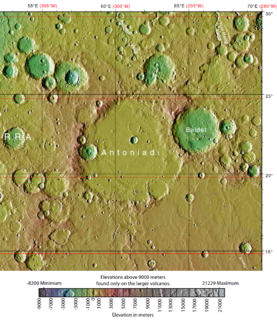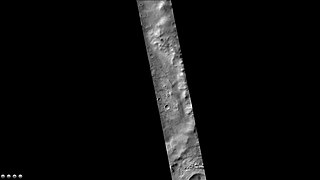
A planet is an astronomical body orbiting a star or stellar remnant that is massive enough to be rounded by its own gravity, is not massive enough to cause thermonuclear fusion, and has cleared its neighbouring region of planetesimals.
Lí Ban may refer to an otherworldly female figure in Irish mythology.
In logic, a truth function is a function that accepts truth values as input and produces a truth value as output, i.e., the input and output are all truth values. The typical example is in propositional logic, wherein a compound statement is constructed by one or two statements connected by a logical connective; if the truth value of the compound statement is determined by the truth value(s) of the constituent statement(s), the compound statement is called a truth function, and the logical connective is said to be truth functional.

Davies is a crater on Mars located at 46°N 0°E on the fringe of Acidalia Planitia near Arabia Terra. It is approximately 48 km in diameter. The crater's name was formally approved by the IAU in 2006.

Mons Hadley is a massif in the northern portion of the Montes Apenninus, a range in the northern hemisphere of the Moon. It has a height of 4.2 km (14,000 ft) above the adjacent plain and a maximum diameter of 25 km at the base.

Serglige Con Culainn, also known as Oenét Emire is a narrative from the Ulster Cycle of Irish mythology. It tells of a curse that fell upon the warrior Cú Chulainn as a result of his attacking otherworldly women, and his eventual recovery by reluctantly agreeing to give military aid to those he had wronged. His developing relationship with one of the Otherworldly women, Fand, occasions his wife Emer's "only jealousy."

Sagan is an impact crater on Mars, located in the Oxia Palus quadrangle at 10.8° N and 30.7° W. It measures approximately 90 kilometers in diameter and was named after an American astronomer Carl Sagan, who founded the Planetary Society. The naming was approved by IAU's Working Group for Planetary System Nomenclature in 2000.

Fand is a village in Howmeh Rural District, in the Central District of Garmsar County, Semnan Province, Iran. At the 2006 census, its population was 394, in 100 families.

Maggini is a large Martian impact crater in northwestern Arabia Terra, located in the Arabia quadrangle at 28.0° N and 350.6° W. It measures 143.0 kilometers in diameter and was named after Mentore Maggini. The name was approved by IAU's Working Group for Planetary System Nomenclature in 1973.

Jones is an impact crater on Mars, located at 19.1°S 19.9°W in the Margaritifer Sinus quadrangle. It measures 94.0 kilometer in diameter and was named after English astronomer Harold Spencer Jones (1890–1960). The name was approved in 1973, by the International Astronomical Union (IAU) Working Group for Planetary System Nomenclature (WGPSN).

Huxley is a crater in the Hellas quadrangle of Mars, located at 63.0°S latitude and 259.2°W longitude. It is 107.0 km in diameter. It was named after British biologist Thomas Henry Huxley, and the name was approved in 1973 by the International Astronomical Union (IAU) Working Group for Planetary System Nomenclature (WGPSN).

Fontana is a crater in the Thaumasia quadrangle of Mars, located at 63.2°S latitude and 72.2°W longitude. It is 80.0 km in diameter and was named after Francesco Fontana, and the name was approved in 1973 by the International Astronomical Union (IAU) Working Group for Planetary System Nomenclature (WGPSN). The picture below shows dust devil tracks and dunes on the crater's floor.

Fournier is an impact crater in the Iapygia quadrangle of Mars, located at 4.4°S latitude and 287.4°W longitude. It is 118.0 km in diameter and was named after Georges Fournier, and the name was approved in 1973 by the International Astronomical Union (IAU) Working Group for Planetary System Nomenclature (WGPSN).

Baldet Crater is an impact crater in the Syrtis Major quadrangle of Mars, located at 23.0°N latitude and 294.6°W longitude. It is 180.0 km in diameter and was named after Fernand Baldet, and the name was approved in 1973 by the International Astronomical Union (IAU) Working Group for Planetary System Nomenclature (WGPSN).

Gill Crater is an impact crater in the Arabia quadrangle of Mars, located at 15.9°N latitude and 354.6°W longitude. It is 83.0 km in diameter and was named after David Gill (astronomer), and the name was approved in 1973 by the International Astronomical Union (IAU) Working Group for Planetary System Nomenclature (WGPSN).

Millochau is an impact crater on Mars, located in the Iapygia quadrangle at 21.4°S latitude and 275.0°W longitude. It measures 115 kilometers in diameter and was named after French astronomer Gaston Millochau. The naming was approved by IAU's Working Group for Planetary System Nomenclature in 1973.

Holmes is an impact crater in the Mare Australe quadrangle of Mars, located at 75.0°S latitude and 293.2°W longitude. It is 122.0 km in diameter and was named after Arthur Holmes, and the name was approved in 1973 by the International Astronomical Union (IAU) Working Group for Planetary System Nomenclature (WGPSN).
















